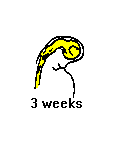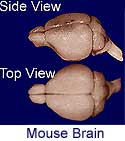 |
Changing Cortical Size and Shape
Beta-catenin may Regulate Brain Shape |
 |
Changing Cortical Size and Shape
Beta-catenin may Regulate Brain Shape |
 Image courtesy of the Comparative Mammalian Brain Collections |
By Melissa Lee Phillips Neuroscience for Kids Consultant August 29, 2002
|
| The scientists studied mice that were genetically engineered to
overexpress a protein called beta-catenin. Beta-catenin was already
known to be involved in mammalian brain development, and it appeared
to be connected to some human cancers. Therefore, it was logical that it
might be important for the regulation of cell numbers. When the
researchers looked at mouse embryos that contained an excess of
beta-catenin, they found that the brains were abnormally large.
Additionally, the brains were now folded, and therefore had an even larger
surface area. Although the surface area of these mouse brains increased,
the thickness of the brain tissue remained about the same. Chenn and Walsh were interested in why the brains were bigger. Were cells dividing more quickly? Were fewer cells dying? The answer to both of these questions was "No." During development, young cells are unspecific. In other words, they have the potential to become many different types of cells. The cells continue to divide until they "choose" to become a specific type of cell. In the engineered mice with more beta-catenin, many of the young cells chose to stay in the cell cycle and keep dividing longer than usual. Eventually, they chose to become mature neurons, but because they divided for a longer period of time, there were many more of them. This increased number of neurons resulted in a larger brain volume and in an increased surface area. |  Image courtesy of Comparative Mammalian Brain Collections |
| Altering genes that regulate the cell cycle can increase brain volume without significant changes in brain surface area. Also, reducing the amount of cell death can increase both brain volume and surface area. However, this method also produces an increase in cortical thickness which can cause severe abnormalities in the animal. In contrast, beta-catenin appears to promote the beneficial expansion of brain surface area without the debilitating increases in brain thickness. This one protein may be very important in regulating the entire shape of the brain. |
 Hear IT! |
Gyri | Gyrus | Sulcus | Sulci |
 For
references and more information, see: For
references and more information, see:
|
| GO TO: | Neuroscience In The News | Explore the Nervous System | Table of Contents |
![[email]](./gif/menue.gif) Send E-mail |
 Get Newsletter |
 Search Pages |